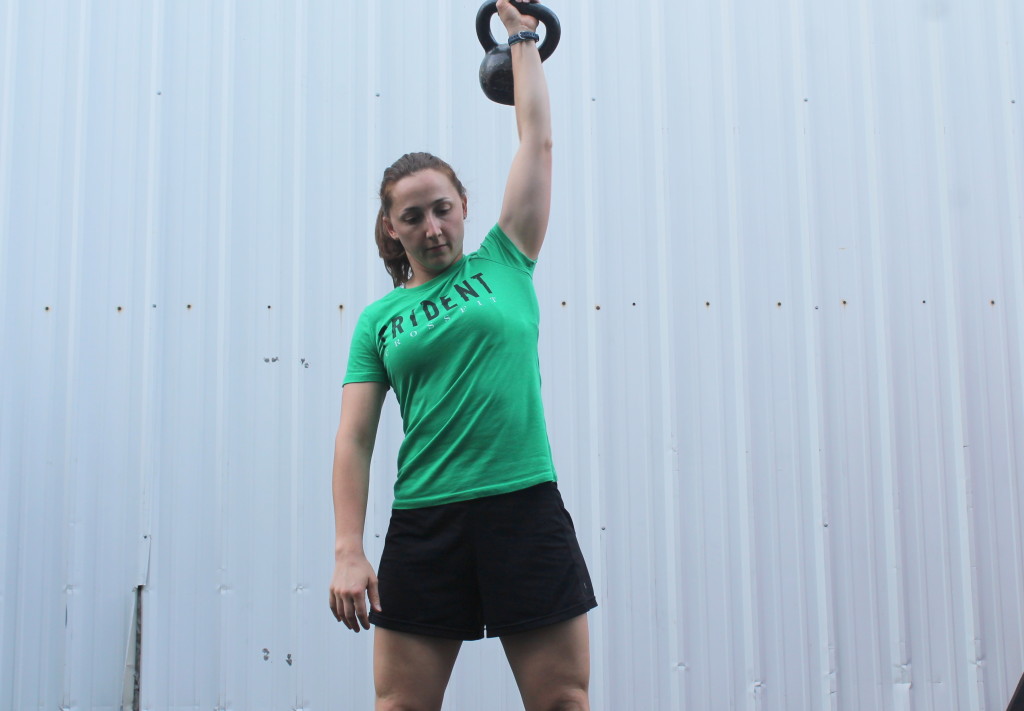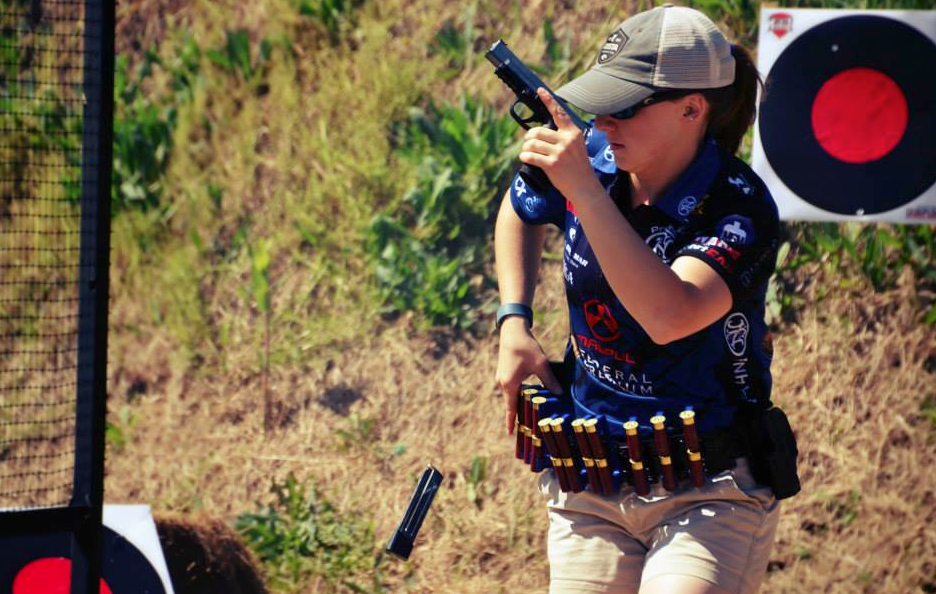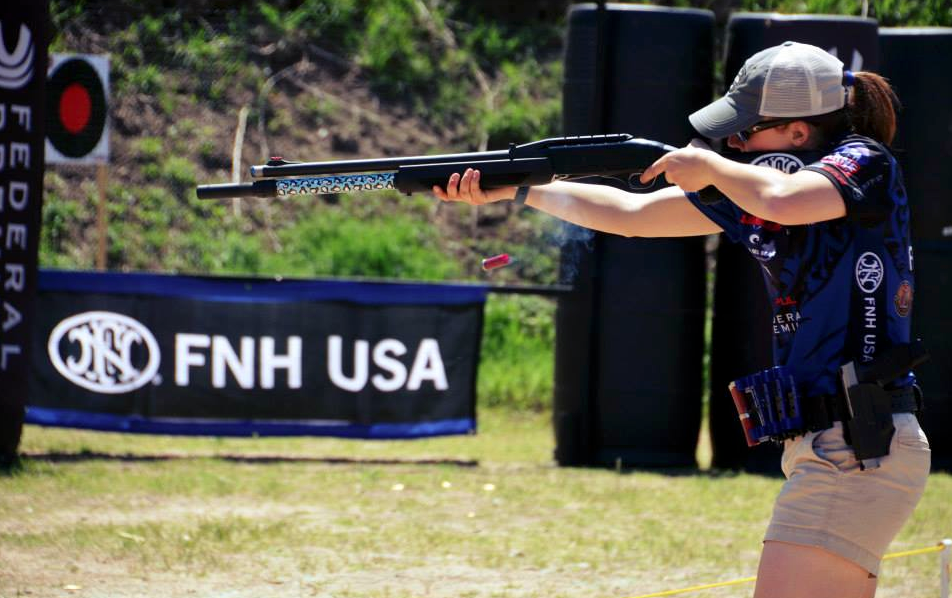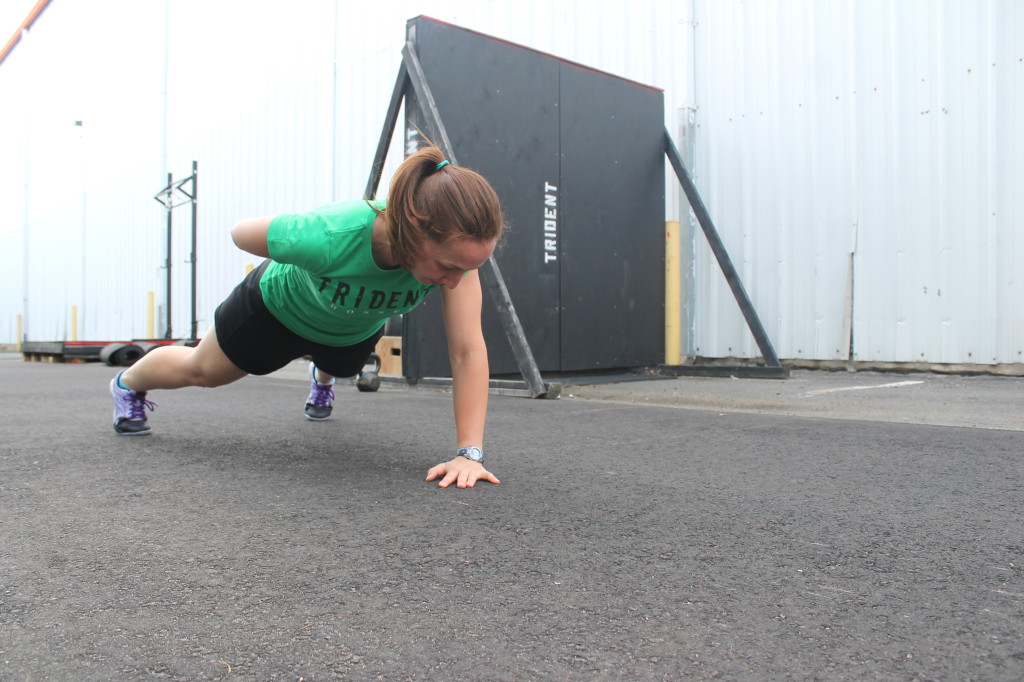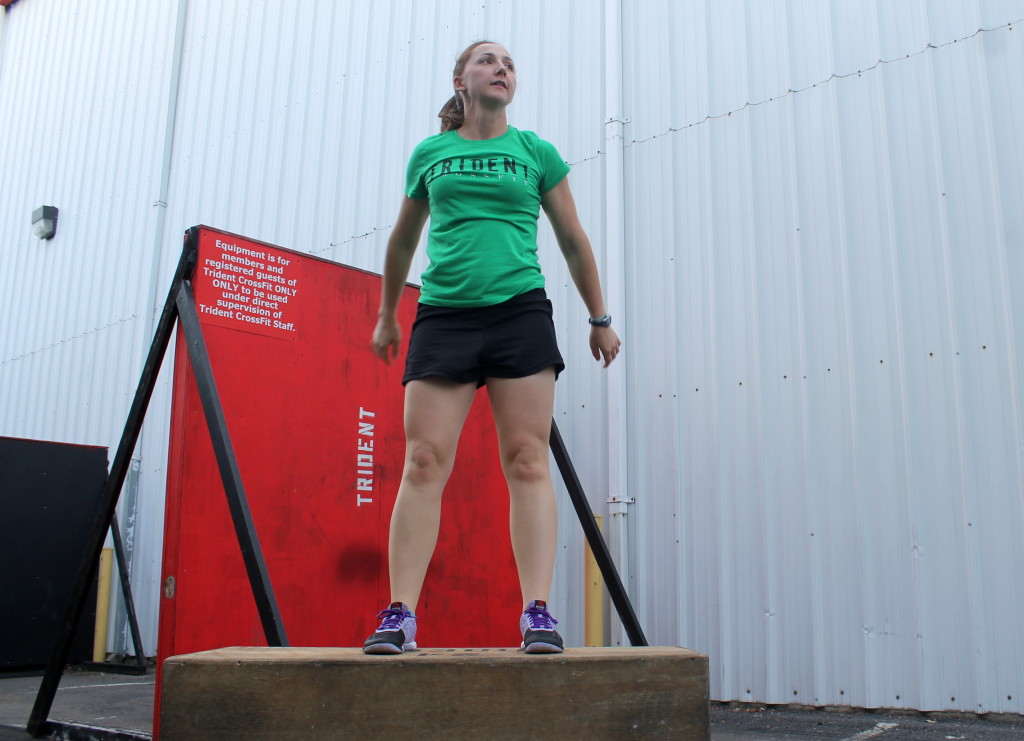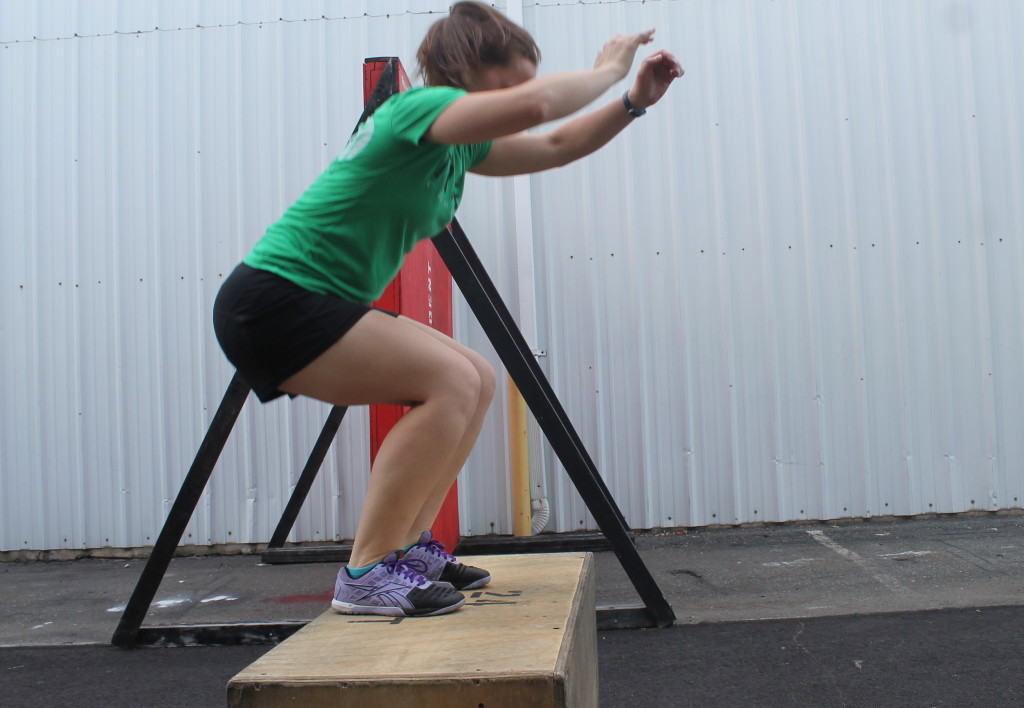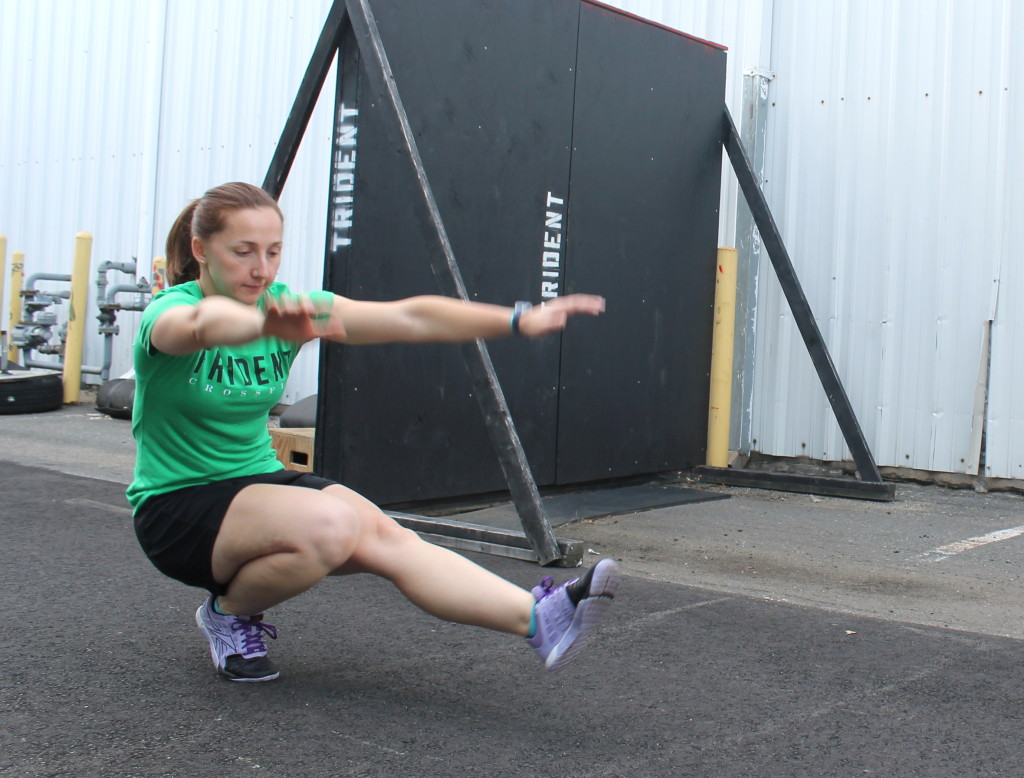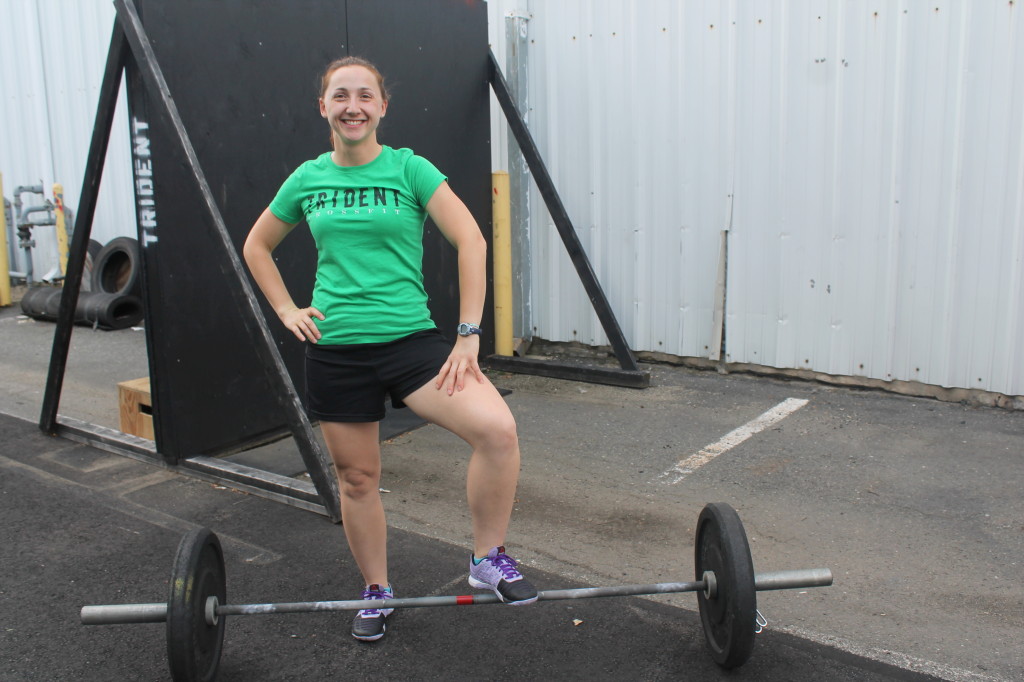Every athlete has a story. Luckily, I know a few with inspiring ones right at Trident CrossFit, where I WOD my heart out 4-5 times a week.
Like many CrossFitters, Karla Herdzik started off doing it to train for another sport. She competes in the sport of 3-gun, which is an action-packed combination of rifle, pistol, and shotgun, in which you navigate through a course of fire as quickly as possible while still maintaining accuracy and of course, safety.
After beginning CF, Karla soon realized she was hooked — but not without a few hiccups along the way. I interviewed her this week about her bumpy start into CrossFit and what made her stick around — and THRIVE — through it all.
1. How did you decide to start doing CrossFit?
A couple of my coworkers used to coach at Trident. They’ve both since moved out of town, but at the time, they were always wearing Trident shirts into the office, talking about how sore they were from their workouts, and how much they absolutely loved this place.
When I first got sponsored by FNH USA to shoot on their 3-gun team, I decided that I needed to get stronger if I wanted to be able to run my rifle and shotgun effectively. I was looking to improve my core and upper body strength, and my coworkers convinced me to give CrossFit a shot.
I never had to hunt for the perfect box like a lot of people do; my coworkers had already found it for me. It was always only ever going to be Trident.
2. How do CrossFit and shooting intertwine? Can you explain a bit about your shooting background as well?
I’ve been shooting competitively since 2008, when I started pistol-only matches. I picked up 3-gun in late 2010, and was invited to be a part of Team FNH USA in late 2011. Firearms manufacturer FNH USA is my primary sponsor, but I am blessed to also be sponsored by a number of other giants in the shooting industry: Winchester Ammunition, Magpul, Leupold Optics, Safariland, Surefire, Vertx, UnderArmour, SKB Cases, Warne Scope Mounts, MGM Targets, SportEAR, Eberlestock, Costa del Mar, Timney Triggers, and Carbon Arms. These sponsorships made it possible for me to shoot the best gear at 14 major matches nationwide last year.
CrossFit and 3-gun have plenty of overlap. Many of the 10 basic physical skills of CrossFit are integral parts of the sport of 3-gun: speed, agility, strength, balance, and accuracy; therefore, improvements that I make in these aspects in the box translate over to my performance on the range. Also, check out 5 ways CrossFit makes me a better shooter here.
Aside from the physical aspects, CrossFit and competitive shooting are also similar because of their community atmospheres. You’ll see the same folks at matches across the country, and some of your fiercest competitors are some of your best friends. If your gear breaks, others will lend you theirs. They’ll share their strategies to help you succeed. They’ll share road trips and hotel rooms and ammunition with you because you’re a part of their 3-gun family.
3. What was your first impression of CrossFit?
I remember my former coworker telling me about a team CrossFit competition he did one weekend. There was running with atlas stones and something about a giant log. As he was telling me how hard it was and how much it crushed him, there was still a huge smile on his face because he couldn’t hide how much he loved it. I was intrigued by how much he could still love the sport in spite of all the suck involved.
I watched one class at Trident a few days before I did my baseline and remember thinking that I wasn’t sure if I was gonna like this “group fitness” thing. I didn’t want everybody watching me. But hey, I was gonna give it a shot.
The night of my baseline with coach Emily, I heard Flo Rida’s “Good Feeling” for the first time. Something about that song, combined with my nervous energy about my upcoming journey to fitness, put a huge smile on my face. That song became my Crossfit anthem, and it still makes me giddy whenever it comes over the speakers at the box.
Emily yelled, “3, 2, 1, go” and 6:38 seconds later (with ring rows and pushups on my knees), I was hooked.
4. How long had you been there when you got Rhabdo? Can you explain exactly what happened, the recovery process?
Note: Rhabdomyolysis is a serious syndrome due to a direct or indirect muscle injury. It results from a breakdown of muscle fibers and release of their contents into the bloodstream.
I got rhabdo on my 4th day at CrossFit. It was a chipper: 50 push presses with the bar; 40 burpees; 30 calorie row; 20 wall balls; and 10 pull-ups. Then as a special Christmas surprise, we cut it in half and did it again backwards, yay!
It was the combination of push press and burpees that did me in – high reps at light weight, targeting the weakest muscles in my body. But I was in decent shape before I came to CrossFit, so I never reached failure. I did the whole thing. It was a perfect storm, really. I was in good enough shape to do enough work to wreck myself, but in bad enough shape that doing all that work wrecked me.
I drove home that night holding the bottom of the steering wheel because I couldn’t lift my arms to hang on at 10 and 2. My parents arrived into town later that evening for Christmas, and hugging them was exceedingly difficult. The next day, I was seriously sore, but thought I was just being a wimp and that it’d get better. Only it didn’t get better; it got worse. The second day – Christmas Eve – I woke up with my arms swollen like overfilled water balloons. I couldn’t lift them. I couldn’t bend them. And the pain only continued to increase.
By this point, I had explored The Googles enough to realize that I might have rhabdo, but I was lacking the key indicator – the blood in my urine – for nearly 48 hours after the workout. It showed up eventually, and that was the signal that now was the time to go to the hospital! So much for Christmas Eve candlelight service at church. We spent it in the emergency room, where I broke down and cried because it hurt so much and the morphine wasn’t doing anything to help with the pain.
They threw me in an ambulance, and sent me over to the hospital. I spent the next 5 days with a wide-open IV in my arm, which they used to flush all the proteins and junk out of my system as quickly as possible before it had a chance to settle into my kidneys and cause severe damage. The swelling slowly went down, as did my protein levels, and eventually I was allowed to go home.
My doctors told me to do NOTHING for 30 days. No physical activity whatsoever. So I spent the next week on my couch before I went back to work for a half day. The simple act of getting dressed that morning crushed me. The walk in from the parking lot to my desk felt like a marathon. I think I made it to noon before retreating home to my bed. The exhaustion carried on for months afterwards.
So, a month after I got out of the hospital, I had a blood test that confirmed my protein levels were back to normal. I was allowed to go back to the gym! Chriss and Andrea (Trident owners & coaches) sat down with me in their office one night and Chriss made me write on the whiteboard something that would define the next 6+ months of my fitness journey: “It’s easy to be hard; it’s hard to be smart.” Over the next several months, they made the time to be personally present for most of my workouts.
We took a very conservative approach to my recovery and erred on the side of caution whenever a movement or a rep scheme was in question. I kept records of what I did and how I felt afterwards. I progressed from one workout a week at a drastically reduced rep scheme and effort level, to finally graduating from “less than 3 months” at about 6 months into my CrossFit journey. Every time we made a jump in the level of effort or the number of workouts in a week, I got my blood tested that weekend. If my protein levels were normal, we moved forward; if not, we stayed on that same level for another week. It was slow and frustrating, but it was safe, and most importantly, I didn’t re-injure myself.
For more on what to do if you find yourself with a case of Rhabdo, check out this
5. What made you decide to give CF another try after healing from rhabdo?
It was never even a question for me. My doctors at the hospital told me never to go back. But there was something about the physical challenge combined with the community atmosphere that I had already discovered that made me ask when I could go back to CrossFit, not wonder if I should.
As evidence of the community, I received a phone call from Trident owner, Chriss Smith, while I was in the hospital. I had been at his gym for all of 4 days and had never met the man. It was Christmas, and I later found out that his father had passed away that week. In spite of all that, he took the time to check up on me because I was now part of his Trident family. There was no way I could walk away from that!
6. Having experienced it, what do you make of the folks that put down CF because it can lead to rhabdo or other injuries?
Having experienced it, I can say that yes, it is every bit as bad as it sounds. But I also know that I could’ve just as easily have given myself rhabdo running too far or working out at Globo Gym.
Every sport has inherent risks, whether it’s concussions in football and soccer, or sprained ankles in basketball, or broken bones in snowboarding. Every sport takes measures to mitigate these risks, but inevitably there will still be injuries. CrossFit is no different.
And to be clear: Rhabdo is wicked rare. There are only something like 20,000 cases of rhabdo in the US every year and the majority of those are caused by crush injuries or drugs. Exertional rhabdomyolysis accounts for only a small percentage of Rhabdo cases in the US each year. I simply believe the widespread benefits of CrossFit outweigh the rare risks.
7. What do you like best about CrossFit? Favorite Workout? Least Favorite?
It’s hard to pick what I like most. The Olympic lifts. The community. The challenge. The bacon. I love it all!
My favorite workout is probably Grace, because I love cleans SO MUCH. I am also a huge fan of Hero WODs because of their significance. My least favorite is anything with thrusters or wall balls, because they are the devil.
8. What is your greatest CF accomplishment?
I’ve achieved a fair amount of milestones in CrossFit: a bodyweight front squat; putting my bodyweight overhead; butterfly pull-ups; a 2x bodyweight deadlift; and a L1 Cert. But I think my greatest accomplishment was Superfit DC 2012 right here at Trident. Just 10 months after Rhabdo, Jennie Cooper and I survived 5 workouts over 2 days to take 3rd place scaled at our first competition.
9. Why do you think so many people are drawn to this sport?
I think people are drawn to CrossFit because it’s so real. In an age where everything is so over-processed, temporary, and automatic, I believe people are looking for something pure, basic, and substantive. CrossFit provides that and produces real, lasting results. The results don’t come easy – you can’t pick up some results at the drive-through. They have to be earned over time through, sweat, blood, and pure effort. The results don’t fade quickly like the latest internet sensation is forgotten by next week. They stick with you and continue to affect your life long after you’ve mopped up your puddle of sweat.
Also, I think people are drawn to CrossFit because of the bacon. At the very least, it helps people to stick around!
10. What tips would you give someone who wanted to begin CF?
Do it. Do it now. You won’t regret it for a minute. Just be smart about it. Your fitness journey is a long one, so there is no need to rush and break yourself.
11. What in your life has improved or changed as a result of CF?
Emotionally, I am in a much better place. I started CrossFit shortly after I got divorced. I was depressed and lonely; I found happiness and a new family. I gained self-confidence and realized there are very few challenges in life that can’t be overcome with some prayer and an hour with a heavy barbell.
Physically, I weigh a little more than I did 3 years ago, but it’s shaped much differently now. My quads got thicker, my butt got rounder, yet my pants size is smaller. My chronic back pain from sitting in front of a computer all day is still present, but is much more manageable. Also, my thick legs are the closest to having actual visible ankles than they have been in my whole life!
12. Is the “community” aspect of CF like people say it is? How so?
CrossFit is definitely about community. There’s something about suffering through workouts, setting goals, achieving them, and sometimes failing that brings people together. Nevermind that you have nothing in common with many of those people outside of the gym; inside the box, you are kindred spirits that are pursuing the same goal: to be the greatest version of yourself that you can be. And people pursuing the same interests is the very definition of community.
But CrossFit is more than community; it is family. It is home.
13. What else might you want to add about your experience with this sport?
CrossFit is about more than barbells and pull-ups. CrossFit helps you PR at life. CrossFit makes you physically strong, but it also makes you good at life. It means you are strong and you are confident because you’ve tackled every challenge that CrossFit has thrown at you, and you’ve overcome it, so you can easily take on life’s challenges as well.
***If you live in the DC-area and want to give it a try, check out Trident CrossFit. Obviously, Karla and I are both die-hards. It is honestly the best fitness experience I’ve ever had, and changed my life for the better.

